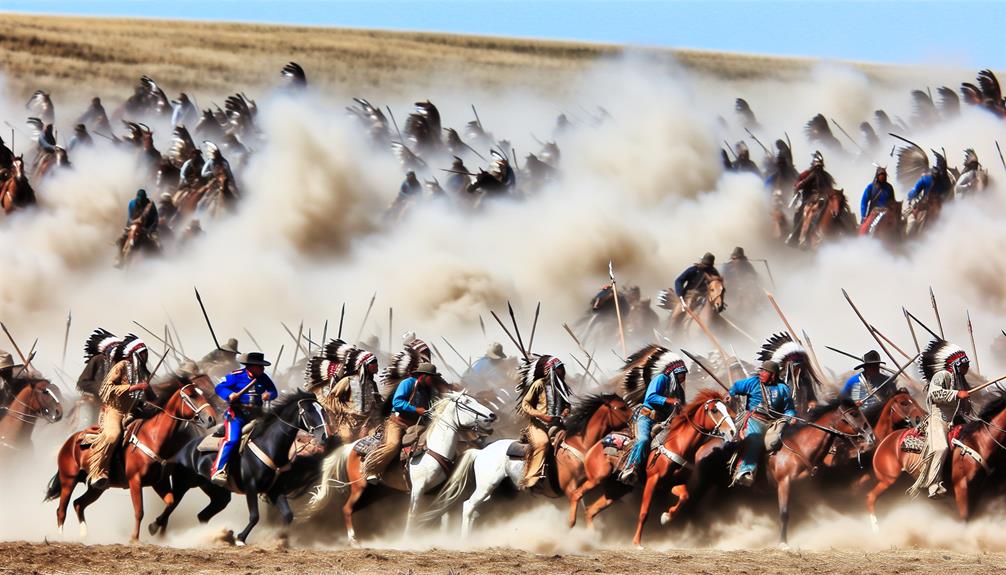The Battle of Little Bighorn stands as a pivotal moment in American history, representing a complex intersection of military strategy, cultural conflicts, and historical repercussions. General Custer's decisions and the events leading up to the battle remain subjects of scrutiny and analysis, shedding light on the dynamics between Native American tribes and the expanding U.S. government. As the dust settled on the battlefield, the implications of Custer's Last Stand rippled through time, leaving a legacy that continues to intrigue historians and provoke discussions on the lasting impact of this fateful encounter.
Key Takeaways
- Custer's Last Stand at Little Bighorn occurred in 1876.
- Custer's aggressive tactics backfired during the battle.
- Native American leaders like Sitting Bull and Crazy Horse were pivotal.
- Battle showcased Native warriors' military prowess and strategies.
- Outcome impacted U.S. military tactics and Native American resistance.
Background of the Battle
The Battle of Little Bighorn, also known as Custer's Last Stand, took place on June 25-26, 1876, between the combined forces of the Lakota, Northern Cheyenne, and Arapaho tribes and the 7th Cavalry Regiment of the United States Army led by Lieutenant Colonel George Armstrong Custer. This battle holds significant contextual importance as it represents one of the most famous military engagements in the history of the American West. The clash emerged from the tensions between Native American tribes defending their land and the U.S. government seeking to expand its territories.
Military strategies played a pivotal role in shaping the outcomes of the Battle of Little Bighorn. The 7th Cavalry Regiment, under Custer's command, intended to surprise and overwhelm the Native American encampments quickly. However, due to a series of strategic miscalculations and communication errors, the plan backfired. Custer divided his forces, weakening their overall strength and leaving them vulnerable to the united Native American tribes.
On the other hand, the Native American tribes employed their knowledge of the terrain to their advantage. They strategically positioned themselves, making it difficult for the cavalry to launch a coordinated attack. Additionally, the Native warriors' fierce resistance and coordinated efforts showcased their military prowess and determination to defend their way of life against the encroaching forces.
Key Players and Forces
Among the key players and forces in the Battle of Little Bighorn, notable figures from the Native American tribes and the 7th Cavalry Regiment under Lieutenant Colonel George Armstrong Custer stood at the forefront of the conflict. Custer's strategy was to divide his regiment into three battalions, with the expectation of encircling and defeating the Native warriors. On the other side, the Native warriors, including Lakota Sioux, Cheyenne, and Arapaho tribes, were led by prominent leaders such as Sitting Bull, Crazy Horse, and Gall. These leaders coordinated their forces effectively, utilizing their knowledge of the terrain and employing tactics that capitalized on the mobility and stealth of their mounted warriors.
Lieutenant Colonel George Armstrong Custer, a renowned Civil War veteran, was known for his aggressive and daring approach to warfare. However, his bold tactics proved to be his downfall during the Battle of Little Bighorn. Custer's decision to split his forces in the face of a substantially larger Native American encampment ultimately led to a disastrous defeat for the 7th Cavalry Regiment. Despite his military experience, Custer underestimated the size and determination of the Native warriors, which contributed to the devastating outcome of the battle.
In contrast, the Native warriors demonstrated strategic prowess by utilizing their knowledge of the land to outmaneuver and overwhelm Custer's forces. Their coordinated efforts and superior numbers played a pivotal role in securing victory at the Battle of Little Bighorn.
Tactical Decisions and Mistakes
Strategizing and executing tactical decisions played a pivotal role in shaping the outcome of the Battle of Little Bighorn. Colonel Custer's strategic errors greatly influenced the course of the battle. One critical mistake was dividing his forces, leading to a fragmented approach that weakened the overall effectiveness of the U.S. Army's attack. Custer split his regiment into three battalions, with his own contingent taking the riskier route towards the Little Bighorn River.
Moreover, Custer's inadequate reconnaissance and underestimation of the size and strength of the Native American coalition led by Sitting Bull were also key strategic errors. This lack of accurate intelligence compromised the American forces' ability to formulate a successful tactical response.
On the battlefield, Custer's reliance on traditional cavalry tactics proved to be another detrimental factor. The open terrain of the Little Bighorn area did not favor traditional cavalry charges, giving the Native American warriors an advantage with their knowledge of the terrain and superior numbers. Custer's rigid adherence to outdated tactics limited the adaptability of his forces, ultimately contributing to their defeat.
In contrast, the Native American forces effectively utilized their knowledge of the land and guerrilla warfare tactics to outmaneuver and outflank the U.S. Army. Their flexible approach to the battlefield and coordinated attacks capitalized on Custer's strategic errors, securing a decisive victory at the Battle of Little Bighorn.
The Battle Unfolds
As the Battle of Little Bighorn unfolded on the vast plains of Montana, a series of intense and chaotic engagements ensued between Colonel Custer's forces and the Native American coalition led by Sitting Bull. The battle strategy employed by Custer was to divide his regiment into three battalions, aiming to encircle and defeat the Native American encampment. However, this strategy proved to be a pivotal mistake as it led to the isolation and eventual annihilation of his troops.
From the Native Americans' perspective, the unfolding battle presented an opportunity to defend their lands and way of life against the encroaching U.S. Army. The coalition of Lakota Sioux, Cheyenne, and Arapaho warriors utilized their knowledge of the terrain to their advantage, launching coordinated attacks on Custer's divided forces. Their strategic use of the landscape, combined with their fierce determination to protect their families and resources, played a significant role in the outcome of the battle.
The clash at Little Bighorn was marked by fierce fighting and acts of bravery on both sides. The Native American warriors, fighting to preserve their ancestral lands, demonstrated exceptional skill in mounted combat and guerrilla tactics. Custer's forces, though ultimately defeated, fought valiantly in the face of overwhelming odds. The unfolding events at Little Bighorn would go on to become a defining moment in the history of the American West, shaping the legacy of both Colonel Custer and the Native American tribes involved.
Aftermath and Impact
The aftermath of the Battle of Little Bighorn reverberated through American history, leaving a lasting impact on the perception of Native American resistance and U.S. military strategy. The consequences of this battle were profound. For the Native American tribes, particularly the Lakota Sioux and Cheyenne, it was a short-lived victory. The U.S. government intensified its efforts to subdue and relocate them onto reservations, leading to further conflicts and loss of their traditional lands.
On the other hand, the cultural impact of the Battle of Little Bighorn was significant. It cemented the image of General George Custer as a tragic hero in American folklore, his defeat becoming a symbol of Native American defiance against the encroachment of white settlers. This event also highlighted the need for a reassessment of U.S. military tactics in conflicts with indigenous peoples. The failure at Little Bighorn prompted the military to adapt its strategies, focusing on overwhelming force and coordination to prevent similar defeats in the future.
Legacy and Historical Interpretations
Examining the enduring legacy and various historical interpretations surrounding the Battle of Little Bighorn sheds light on the complexities of this pivotal event in American history. The historical significance of the battle lies in its role as a symbol of Native American resistance and victory over the U.S. military. For Native American tribes, the Battle of Little Bighorn represents a moment of triumph and resilience against the encroachment of their lands. Conversely, from the American perspective, it stands as a stark reminder of military failure and the loss of General Custer and his men.
The historical interpretations of the Battle of Little Bighorn have been a subject of controversy. Some view Custer as a heroic figure who valiantly fought against overwhelming odds, while others criticize his decisions and tactics, attributing the defeat to his arrogance and underestimation of the Native American forces. The portrayal of Native American leaders like Sitting Bull and Crazy Horse also varies, with some depicting them as strategic geniuses and others as ruthless aggressors.
The legacy of the Battle of Little Bighorn continues to spark debates and discussions among historians and the public, highlighting the complexities of interpreting historical events. The clash of perspectives and the ongoing reevaluation of the battle's significance demonstrate how history is not fixed but constantly evolving through new discoveries and changing societal values.
Visiting the Little Bighorn Battlefield
Located in Montana, the Little Bighorn Battlefield offers visitors a unique opportunity to engage with a significant historical site that played a pivotal role in American history. Exploring trails at the battlefield allows visitors to walk in the footsteps of soldiers and Native American warriors who fought during the Battle of Little Bighorn. The trails provide a tangible connection to the past, offering a deeper understanding of the terrain and strategic elements that shaped the outcome of the battle.
One of the key attractions at the Little Bighorn Battlefield is the Monument tour. This tour takes visitors through the solemn memorial erected in honor of those who lost their lives during the battle. The monument serves as a powerful tribute to the soldiers, scouts, and warriors who fought bravely on both sides. Through the Monument tour, visitors can gain insights into the events leading up to the battle, the strategies employed by the opposing forces, and the ultimate outcome that had far-reaching implications for the Native American tribes and the United States.
Frequently Asked Questions
What Artifacts or Personal Items Were Left Behind After the Battle?
Artifacts and personal items left behind after the battle at Little Bighorn provide valuable insights into the lives and experiences of those involved. These objects can include weapons, clothing, jewelry, and personal effects.
Preserving and studying such artifacts allows for a deeper understanding of historical events and the individuals who participated in them. Researchers carefully document and analyze these items to piece together a more thorough picture of the past.
Are There Any Documented Ghost Sightings at the Battlefield?
Ghostly encounters and reports of supernatural phenomena have long captured the curiosity of many individuals, especially in historical locations or sites of significant events. Documented sightings at battlefields or areas with a violent past often fuel speculation and intrigue.
The phenomenon of ghost sightings at the battlefield adds a layer of mystique and folklore to the site, drawing visitors seeking a connection to the past or a glimpse into the unexplained.
How Has the Landscape of the Battlefield Changed Over Time?
The landscape of the battlefield has undergone significant transformation over time due to various environmental impacts.
Preservation efforts have been instrumental in maintaining the historical significance of the site while accommodating tourist attractions.
Careful management of the terrain has guaranteed that the battlefield retains its authenticity and serves as a poignant reminder of the events that transpired there.
This delicate balance between preservation and accessibility is vital for honoring the site's historical importance.
What Role Did Native American Scouts Play in the Battle?
In military strategy, Native American scouts played a pivotal role by providing valuable insights from a Native American perspective. These scouts, with their intimate knowledge of the land and the enemy's movements, offered essential intelligence that influenced decision-making.
Their ability to navigate the terrain and anticipate enemy movements proved instrumental in shaping the unfolding events of the battle. This collaborative approach between Native American scouts and military commanders highlights the strategic significance of incorporating diverse perspectives in warfare.
Are There Any Lesser-Known Stories of Individual Bravery During the Battle?
When exploring the lesser-known stories of individual bravery during the battle at Little Bighorn, it is crucial to contemplate the myriad accounts that speak to the heroism, courage, sacrifice, and valor displayed by various participants.
These stories shed light on the personal acts of bravery that often go unrecognized in the broader narratives of such historical events.
Examining these accounts provides a more nuanced understanding of the depths of bravery exhibited during moments of conflict.
Conclusion
To sum up, the Battle of Little Bighorn, also known as Custer's Last Stand, remains a poignant chapter in American history, symbolizing the clash between Native American tribes and the U.S. government.
This historic event, marked by strategic errors and devastating consequences, continues to be debated among historians for its lasting impact on Native American resistance and U.S. military strategy.
The battle's legacy serves as a stark reminder of the complexities of warfare and the importance of understanding opposing forces.


